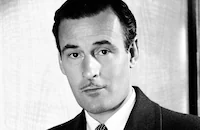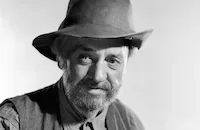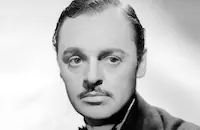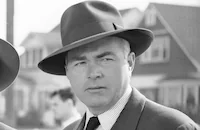Mr. & Mrs. North

Brief Synopsis
Cast & Crew
Robert B. Sinclair
Gracie Allen
William Post Jr.
Paul Kelly
Rose Hobart
Virginia Grey
Film Details
Technical Specs

Synopsis
When publisher Gerald P. North returns to New York from a short business trip to Boston, his scatter-brained wife Pamela is late getting to the train station, then makes the weary Jerry stop at the apartment of a friend, inventor Louis Berex. Unknown to Jerry, Louis has been having an affair with Carol Brent and has asked Pam to convince Carol's husband to grant a divorce. When the Norths finally return home, Jerry finds an expensive gold compact that does not belong to Pam. Just then their friends, patent attorney Stuart Blanton, and Jane and Ben Wilson stop by. When Pam suddenly screams because she thinks a stranger has been in their apartment, Ben recognizes the compact and pockets it. Stuart and the Wilsons then leave, and a few moments later, Pam opens a closet and a body falls out. When Lieutenant Weigand and his partner, Mullins, investigate, Jerry tells them about finding the compact, but it is gone. Pam says that she moved it, then gives the departing policemen one of her own. Pam is about to tell Jerry why she did this when Arthur Talbot, a "Fowler Brush" salesman, knocks on the door. Jerry is in no mood to discuss brooms and tries to chase him away, until Talbot says that he came the day before and the man inside would not let him in. When Pam goes for the mail, she notices the card on their box is covered by one with the name "Blanton" on it. After carefully removing the card, she goes to a party at Stuart's and confronts him. He says he knows nothing about the card and advises Pam to take it to the police. Jerry then arrives and reveals that the body is that of Carol's husband. Hearing this, Jane faints, infuriating Ben. Meanwhile, Louis goes to Carol's place, but because the police are there, pretends that he is just a client paying his respects. When the police question Pam and Jerry again, they admit knowing Carol, but Pam says they never met Brent. The police then question Jerry's secretary, Mabel Harris, to corroborate his alibi for the afternoon of the murder and find an envelope in the office wastebasket, addressed to Brent from Pam. When they later question Stuart, his alibi, corroborated by his servant, Kumi, is that he was in the kitchen preparing a time-consuming lobster dish for a party and did not want to be disturbed. He also tells the police about the card on the letter box, thinking that Pam had already given it to them. The next day, Talbot goes to the district attorney's office to tell his story, but everyone thinks he is selling brushes and refuses to listen. Soon Ben is questioned, but reveals that he just found out Jane was having an affair with Brent. When Talbot finally gets to District Attorney George Heyler's office, Ben is leaving and Talbot recognizes him from the Norths' apartment. When Carol is questioned, Pam arrives and inadvertently reveals Carol's affair with Louis. After Pam leaves, Carol admits that she hated her cruel husband, but says he did not know about the affair. Later, Jerry is questioned by Weigand and Mullins, who reveal that his alibi is suspect. They then search his desk and find a note written by Pam, inviting Brent to their apartment on the afternoon of the murder. She says that Carol asked her to intercede, but Weigand thinks that Jerry murdered Brent out of jealousy, especially after Jerry reveals that he had met Brent briefly two years before. Just then, Heyler calls and says that Ben is the chief suspect because of Talbot's identification. By this time, Jerry really does think that Pam was having an affair and leaves the apartment. While Pam is sobbing in her room, a man sneaks into the apartment and hides in the closet. Then Mr. Barnes, the postman, arrives and tells Pam that on the afternoon of the murder, a friend of hers, someone whose name he does not know, came out of their apartment and that he had just seen that man again. Because the phone line has been cut, she goes next door to call the police and when she returns, Barnes's unconscious body falls out of the closet. At the police station, everyone believes that Jerry is the killer, but through Pam's ramblings, it is revealed that Stuart's alibi is phony because the lobster he served at his party was canned, not homemade. When she calls him a cheat, he starts to leave and takes his hat off the desk, not knowing that Pam brought it to the police after finding it at her place. It is finally revealed that Stuart killed Brent because Brent was going to charge him with defrauding him of $50,000. Finally, the police and the Norths share a friendly breakfast and promise to get together before the next murder.

Director

Robert B. Sinclair
Cast

Gracie Allen
William Post Jr.

Paul Kelly

Rose Hobart

Virginia Grey

Tom Conway

Felix Bressart
Stuart Crawford

Porter Hall

Millard Mitchell

Lucien Littlefield
Inez Cooper

Keye Luke

Jerome Cowan

Fortunio Bonanova
William Tannen

James Flavin
Tim Ryan
Carl Stockdale
Gladden James
Harry Strang
Stanley Andrews
Bob Ryan
Charles Mcavoy
Sam Mcdaniel
Jess Lee Brooks
Barbara Bedford
Harold Minjir
Harry Worth
Ken Christy
Doris Day
John Holland
Gladys Blake
Crew

Videos
Movie Clip



Trailer
Film Details
Technical Specs

Articles
Mr. and Mrs. North
By Richard Harland Smith

Mr. and Mrs. North
Mr. & Mrs. North - Mr. and Mrs. North
There are a few reasons for this, but the one that mattered most was Gracie Allen. The beloved scatterbrained comedienne, foil for her husband George in their Burns & Allen comedy routines, was a veteran of 25 films, mostly, in effect, playing herself. She had most recently filmed The Gracie Allen Murder Case (1939). It arose from the wish of their friend, the popular mystery writer S.S. Van Dine, to write her into a novel in his Philo Vance series. He did, and it was filmed with Gracie discombobulating the usually suave Vance of Warren William, a sort of American Sherlock Holmes. The formula in which a loose cannon of a woman upends a man works for screwball comedy, in fact almost defines the form. But it turned Vance into a fish out of water.
And it throws off the chemistry between the Norths. Never aspiring to the soigne sophistication of the Charleses, the Norths lived plainer lives in a Greenwich Village flat (although in the movie it's a more upscale Village apartment with a doorman). Unlike the idle Charleses, bouncing drolleries off one another, often from a reclining position, Gerry North worked, in publishing. Although they solved a murder a week for years, they never see themselves as anything but amateurs. But they are puzzle solvers. And the Lockridges were accomplished at their craft. They knew how to construct them, put all the clues out there, and play fair with their audiences. The Charleses appealed to audiences because their carefree lifestyle represented Depression-era escapism to penthouses and martini shakers. They solved crimes, when they solved them (because Nick didn't really want to) for fun, to stave off boredom.
The Norths, on the other hand, represent a more mundane existence, not exactly carefree, but maybe one rung up the ladder from the lives of most of their audiences. They solve crimes because bodies, in effect, keep getting dumped on them. Here, a stiff falls face first out of a closet in their flat. Gerry had been out of town. Gracie was out shopping. In no time, bland WASPy types fill the room, as if from a party list, misdirection ensues as domestic and extracurricular tangles are bared, and the well-tailored crowd, when it isn't gathered around the Norths' piano singing Arthur Freed songs, or marching through police headquarters with its smart cop-dumb cop team prodding them with questions and assumptions (would-be know-it-all dumb cop Millard Mitchell was a carryover from the Broadway stage version, Paul Kelly plays the smart one), angrily fills the air with accusations.
They all seem practically interchangeable. Just as there's a modicum of enjoyment to be gleaned from the period flavor the woodenness of much of the dialogue is a campfest! -- it's also fun to note the aberrations such as the suspect played by Tom Conway (best remembered as The Falcon, a sort of down-market Philo Vance) at a bit of a loss, stripped of his usual suave demeanor, left with nowhere much to go, looking as if he wandered by mistake into the wrong party.
The acting stalwarts in the Norths' world of hats, gloves and shoulder pads include, by the way, Rose Hobart. Yes, the same Rose Hobart Joseph Cornell built his trancy 1936 experimental film around, named for her, looping and relooping a blue-tinted clip of Hobart's jungle glamour in East of Borneo (1931). The roster of dependable character actors -- Virginia Grey, Jerome Cowan, Felix Bressart (comic relief as a Fuller Brush Man caricature), Thin Man veteran Porter Hall, Keye Luke appearing as cops, suspects, witnesses, all seem little more than stick figures designed to serve as foils for Gracie. George Burns, by the way, doesn't appear. But then he doesn't have to. All the others are, in a sense, George Burns. All, to one degree or another, take turns playing straight man to Gracie.
This is especially true of William Post, Jr.'s Gerry North. He doesn't really collaborate on solving the case with Allen's Pam. He never gets the chance to collaborate at all. We never feel the easy intimacy of a married couple here, the quality that injected a fresh note into a genre so dominated by male loners. Like the rest, he's on the outside, a satellite presence, circling Gracie in wobbly orbit, with perplexed reiterations of "Great Scott" or "Holy smoke!" It's not that Mr. and Mrs. North is altogether without merit. But it's peopled mostly by mannequins, and the simultaneously lively and homey give-and-take that gives the Norths their low-key charm is pulled off course and out of reach, by the decision to turn the film into a Gracie Allen vehicle, even if she does solve the murder by dismembering syntax and logic and rejiggering facts, confidently marching to her own beat. She never seems grounded in the here and now, except in ways that make sense to nobody but her. Until they make sense to everyone. In the end, Mr. and Mrs. North isn't a comedy of murder. It's a comedy of obliviousness, especially to what it could and should have been.
Producer: Irving Asher
Director: Robert B. Sinclair
Screenplay: S.K. Lauren; Owen Davis (play); Richard Lockridge, Frances Lockridge (stories)
Cinematography: Harry Stradling
Art Direction: Cedric Gibbons
Music: Daniele Amfitheatrof (uncredited)
Film Editing: Ralph Winters
Cast: Gracie Allen (Pamela 'Pam' North), William Post, Jr. (Gerald P. 'Gerry' North), Paul Kelly (Det. Lieutenant Luke Weigand), Rose Hobart (Carol Brent), Virginia Grey (Jane Wilson), Tom Conway (Louis Berex), Felix Bressart (Arthur Talbot, Fowler Brush Salesman), Stuart Crawford (Stuart 'Stu' Blanton), Porter Hall (District Attorney George Heyler), Millard Mitchell (Detective Mullins), Lucien Littlefield (Mr. Barnes, the Postman), Inez Cooper (Mabel Harris, Gerry's secretary), Keye Luke (Kumi, Blanton's servant), Jerome Cowan (Ben Wilson), Fortunio Bonanova (Buano).
BW-68m. Closed Captioning.
by Jay Carr
Mr. & Mrs. North - Mr. and Mrs. North
Quotes
Trivia
Millard Mitchell originated his movie role in Owen Davis's play, which opened in New York on 12 January 1941 and ran for 163 performances. Albert Hackett and Peggy Conklin played Mr. and Mrs. North.
Notes
Owen Davis' play was based on three short stories, written by New York drama critic Richard Lockridge and his wife Frances, for The New Yorker. The stories appeared from 23 March through August 3, 1940. Millard Mitchell recreated his role from the Broadway production of the play. According to a news item in Hollywood Reporter and M-G-M publicity materials, Henry O'Neill was cast, but he did not appear in the released film. The same sources, and a publicity still from the film indicated that Olin Howland was cast as a police desk sergeant, but he was not in the released film. Hillary Brooke was listed as a "Guest" in the CBCS, but she was not in the viewed print. Mr. & Mrs. North was Gracie Allen's first film since the 1939 Paramount production, The Gracie Allen Murder Case (see AFI Catalog of Feature Films, 1931-40; F3.1691). Allen made only one additional screen appearance, in a comic routine in the 1944 M-G-M film Two Girls and a Sailor (see below). The characters of "Pam" and "Jerry North" were featured in a television series, also entitled Mr. and Mrs. North, co-starring Richard Denning and Barbara Britton as the title characters and Francis De Sales as their friend, "Lt. Bill Weigand." The series ran on CBS from October 3, 1952 -September 1953, and on NBC from January-July 1954.















